Lady Emma Barnard, the chatelaine of Parham House and Gardens, takes time to show us around her stunning stately home in the heart of Sussex
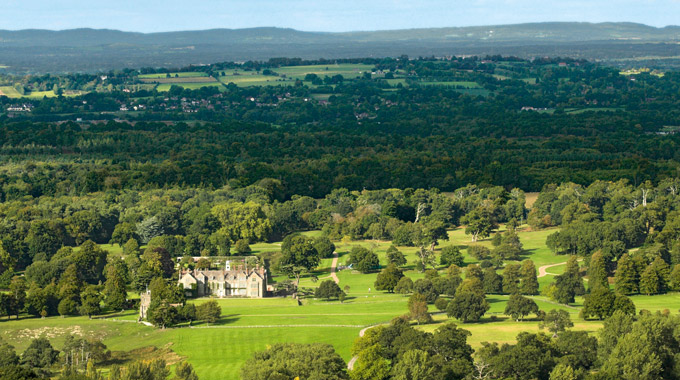
“My heart skips a beat every time I drive in the gate,” confesses Lady Emma Barnard. The route takes her past forests and fields towards her 16th-century home – Parham House, set within 875 acres in the South Downs of Sussex, where its pretty sandy-coloured stone glows in the low-slanting sunshine. Lady Emma and her husband, barrister James Barnard, divide their time between Sussex and London, and they never fail to appreciate the view when they return to Parham House. “I’ve been here for 18 years,” she says, “and we still can’t believe sometimes that we actually live here.”
Lady Emma, born into the Guinness family, is no stranger to splendid historic homes. She grew up at Farmleigh in Dublin, which hosted Queen Elizabeth II when she visited Ireland in 2011. “But there is something very magical about Parham House,” says Lady Emma, who first knew it as the home of her great-grandparents; Clive and Alicia Pearson renovated and furnished it with most of the treasures it now holds. “They had a tremendous sense of humour about themselves, and you can tell. I think that’s what makes Parham so special. In a funny way, it doesn’t take itself very seriously.”
Despite Lady Emma’s insistence that “for all its grandeur, it’s very un-grand,” the 25,000 visitors who typically tour the vast manor between Easter and the end of October every year can’t fail to be impressed by its sheer scale – some 128 rooms, including public and private areas, full of museumworthy portraits and antiques, renowned collections of 17th-century embroidery, and illustrious guests. Legend holds that Queen Elizabeth I may have dined here in the late 1500s. Princess Charlotte came in 1808 and the Duchess of Kent arrived with Princess Victoria in 1821. In 1928, Queen Mary visited, making a rather unceremonial entrance through a farmyard after the royal car took a wrong turn.
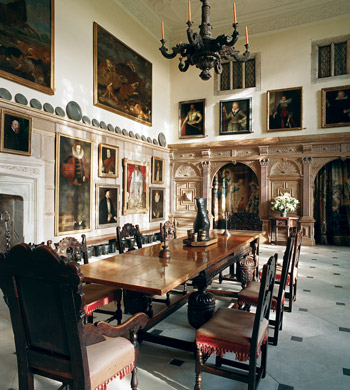
Sir Thomas Palmer – grandson of Robert Palmer, to whom King Henry VIII granted the estate in 1540 – laid the cornerstone of Parham House in 1577. Sir Thomas, who explored the world alongside Sir Francis Drake, sold the home in 1601 to Thomas Bisshopp, a Member of Parliament who also became a knight and later a baronet. The house remained with the Bisshopp family until the Pearsons purchased it in 1922 and set about making it the home it is today.
“The house has had an element of luck, because my great-grandfather was an engineer and what he did at Parham was top notch, done with knowledge, care and research,” explains Lady Emma, heating up a bowl of soup on the blue Aga stove in the casual, 60s-era kitchen of the home’s private quarters. Clive Pearson, whose family firm S Pearson and Co was responsible for major civil engineering projects around the world, worked with architect Victor Heal to remove Victorian additions and strip the house back to its Elizabethan bones, revealing long-forgotten windows and an original fireplace in the Great Room.
The Pearsons also installed electricity and modern plumbing but their greatest contribution was the discerning eye they cast towards furnishing the home. “Everything they bought is here for a reason,” Lady Emma says. “They’re things that tell Parham’s history, or had been at Parham. If something came up at auction that had a provenance to Parham, they often bought it back.”
The home was requisitioned during the Second World War, housing 30 evacuee children from London and, later, several Canadian Infantry Divisions. Despite the dogfights that turned the skies over the Downs into a battleground, the manor survived almost completely intact.
After the war, in 1948, a friend suggested that the Pearsons open rooms to the public, as they were only occupying a portion of the home. At first, they resisted. “It wasn’t because they didn’t want to share it,” Emma says. “My greatgrandparents thought they weren’t important enough and that nobody would come. They were incredibly modest.”
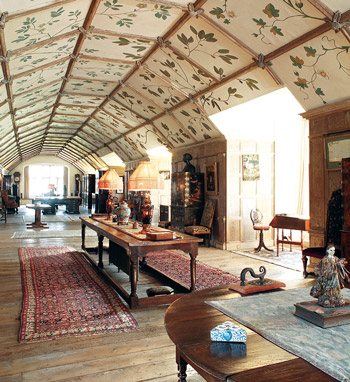
They were persuaded, and the Pearsons proceeded with zeal. Alicia and her eldest daughter, Veronica, conducted the tours themselves and kept their visitors in mind when purchasing objects for the home. “My great-grandmother always said, ‘Gentlemen must have something to look at, too – so we must have clocks!’” Lady Emma laughs.
During the winter ‘off-season’, the rooms are swathed in dust sheets, protecting precious pieces from the light. One gets a sense of tiptoeing into a child’s bedroom, as if to check on the little ones while they’re sleeping, especially given the affection with which Lady Emma treats each object. She interlaces historical notes with her own memories and the stories told to her by her great-grandmother and her great aunt Veronica, who later headed up the household until her passing in 1993, when the torch was passed to Lady Emma.
Exiting her private library through a foyer filled with vases and floral arranging equipment – unchanged since her great-grandmother introduced the tradition of filling the home with “wild and woolly” fresh flowers during the season – Lady Emma draws back a curtain to reveal the Great Hall. It’s a spacious room, with two-storey tall windows overlooking the Downs and magnificent Tudor portraits bedecking the oak panelling.
A painting of Elizabeth I’s favourite, Robert Dudley, with his balding pate and bushy grey beard, casts a weary eye over the intruders, as if reluctantly awakened from a nap. Apparently, though, his dour expression never repressed a bit of horseplay among Lady Emma’s sons (Benjamin, 16 and Arthur, 14) when they were young. “Their greatest treat was to be allowed to ride their plastic tractors around the Great Hall table,” their mother reveals. “They would get closer and closer to the ropes surrounding it and when they thought we weren’t looking, they would try to knock the stanchion over.”
Other illustrated luminaries in attendance include a serious-looking Edward VI, son of Henry VIII and Jane Seymour; Lord Burghley, one of Elizabeth I’s most valued advisors; and a fair-skinned redhead wearing a crown Elizabeth herself, though it’s now believed the woman was Anne of Denmark, wife of James I of England. Notably absent at the moment are a portrait of James I and a Narwhal tusk with its original painted case, which was brought to England more than 400 years ago and touted about as a unicorn horn; both were loaned to the British Museum. A third prized possession, Robert Peake’s circa 1611 portrait of Henry Frederick, Prince of Wales, astride his white horse, is on show at the National Portrait Gallery. The paintings will be returned ready for the spring opening of Parham.
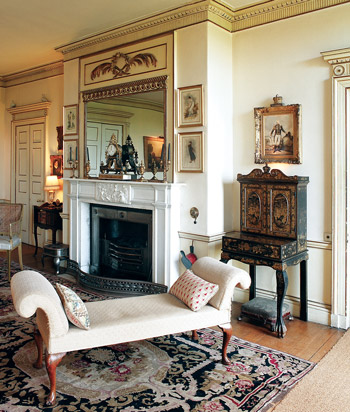
Passing through the Great Parlour, with a 1935 plasterwork ceiling featuring curious animals like the dodo, manatee and llama, honouring the ‘new discoveries’ of the 17th century, visitors arrive in the white-columned Saloon, which once served as Alicia Pearson’s drawing room. “She said they always used to move out of it at this time of year, because the wind would whistle through the windows and practically lift the carpet,” Lady Emma says. Of particular note here is the pair of matching winged armchairs. One is covered in dripping with pearls. At one time, it was thought she was needlework from the early 18th century; the other is a replica stitched by Alicia Pearson and her mother, Lady Brabourne.
Upstairs, the Great Chamber, Alicia Pearson’s erstwhile bedroom, further reveals her passion for needlework. The canopy bed boasts a frame that is partly Tudor, probably from the court of Henry VIII, and is draped in flame stitch embroidered curtains from the 1620s. Lady Emma is partial to a mid-17th century needlework christening-cushion featuring Moses, when he was discovered among the rushes. “The lady who finds him there is so surprised, she’s got two sets of eyebrows. My grandmother loved the quirky,” she recalls.
“A great example of my great-grandparents’ sense of humour is this room,” she says as she enters the Ante-Room, where the walls are filled with beautifully rendered portraits of not only Charles II and his beleaguered bride, Catherine of Braganza, but some of his most famous mistresses, as well. “It is the fact that they hung them all in the same room,” says Lady Emma, shaking her head.
The Green Room features several items related to Sir Joseph Banks, the botanist and naturalist who played a significant role in founding Kew Gardens; his wife’s sister was an ancestor of Alicia Pearson. Perhaps the most fanciful is a painting of a kangaroo, which was based on an inflated skin that Banks brought back from his voyage with Captain Cook. Lady Emma’s favourite room is the Long Gallery, with its barrel-vaulted ceiling adorned with painted vines. “I love the light and the airiness and the fact that it’s right at the top of the house,” she says. “I could sit there for hours.”
There are invaluable possessions here, too, such as the gilt embroidered velvet saddle that belonged to James II. The gallery also features an excellent collection of furniture, and an exhibit about the Pearsons and their contributions to the home, which Lady Emma installed to honour them. But like her great-grandparents, she adores the unexpected little objects, like a grinning Jacobean lion made of shells, thoughtfully placed at a child’s height, and a hide-covered bicycle horse that belonged to her great-great-grandfather, one of the few treasures she brought from Farmleigh.
“It would be fun to add a few more things to the collection, which related to my family,” she says. But, like her relations before her, Lady Emma remains humble about her role at Parham House. “I’m just a tiny link in a very long chain of people that have lived here and loved it and looked after it. It’s been here for centuries and it will outlast us all.”
Parham House and Gardens (Storrington, Nr Pulborough, West Sussex RH20 4HS) is open from April to October. For more information and opening hours tel: 01903 742021 or visit www.parhaminsussex.co.uk. Parham is a member of the Historic Houses Association and offers free access to HHA Friends and Members during normal opening hours.
Related articles
Discover Yorkshire’s hidden secret

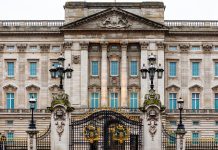
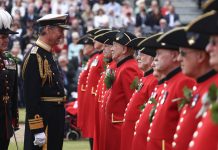
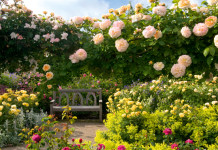

 © 2024
© 2024